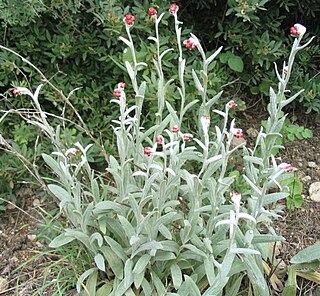
The genus Helichrysum consists of an estimated 600 species of flowering plants in the sunflower family (Asteraceae). The type species is Helichrysum orientale. The name is derived from the Greek words ἑλίσσω and χρῡσός.
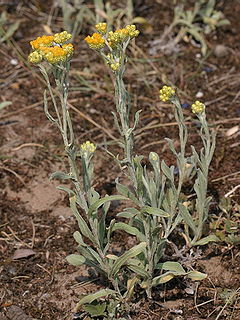
Helichrysum arenarium is also known as dwarf everlast, and as immortelle.
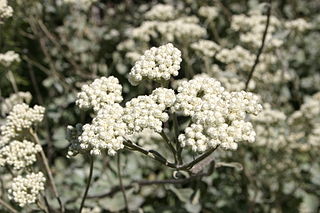
Helichrysum petiolare, the licorice-plant or liquorice plant, is a species of flowering plant in the family Asteraceae, native to South Africa — where it is known as imphepho — and naturalized in parts of Portugal and the United States. Growing to about 45 cm (18 in) high and 150 cm (59 in) broad, it is a trailing evergreen subshrub with furry grey-green leaves and small white flowers. Other common names include silver-bush everlastingflower, trailing dusty miller and kooigoed. The foliage has a faint licorice aroma, but Helichrysum petiolare is not closely related to the true liquorice plant, Glycyrrhiza glabra.

Gnaphalium is a genus of flowering plants in the sunflower family, commonly called cudweeds. They are widespread and common in temperate regions, although some are found on tropical mountains or in the subtropical regions of the world.
Cudweed is a common name for several species, and may refer to:
Helichrysum balfourii is a species of flowering plant in the family Asteraceae. It is found only in Yemen. Its natural habitat is subtropical or tropical dry forests.

Helichrysum melitense, the Maltese everlasting, is a species of flowering plant in the family Asteraceae and is endemic to Malta, specifically on the island of Gozo. It can be found in Dwejra, and in cliffs in Gozo near Fungus Rock. Its natural habitats are Mediterranean-type shrubby vegetation on Coastal garigue and vertical sheer cliffs. Recently, it was recorded in new locations on the island of Gozo. This species is on the decline in the wild, and it is threatened by habitat loss. It is very easy to cultivate, and it is gaining ornamental popularity amongst the locals.

Hypericum scopulorum is a species of flowering plant in the family Hypericaceae. It is endemic to Socotra, an island archipelago that is part of Yemen. It is a common plant in shrubland habitat, and it is a dominant species in some areas along with Cephalocroton and another local endemic, Helichrysum rosulatum.

Helichrysum luteoalbum, the Jersey cudweed, is a species of flowering plant in the daisy family Asteraceae.

Carpesium is a genus of flowering plants in the aster family, Asteraceae. They are distributed in Europe and Asia; most occur in China and several are endemic to the country.

Eublemma minutata, the scarce marbled, is a species of moth of the family Erebidae. It can be found everywhere in Europe, except for Luxembourg, the Netherlands, the northern part of Russia and various islands. In Asia, it can be found only in Lebanon.
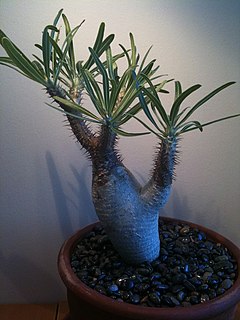
Pachypodium gracilius is a species of Pachypodium endemic to Madagascar. The plant trunk is pachycaul, and typically short and fat. It produces yellow flowers.
Vulcaniella fiordalisa is a moth of the family Cosmopterigidae. It is found from Portugal and Morocco, east to the Balkan Peninsula and Lebanon.

Coronidium scorpioides, commonly known as the button everlasting, is a perennial herbaceous shrub in the family Asteraceae found in Australia. Previously known as Helichrysum scorpioides, it was placed in the newly described genus Coronidium in 2008.

Ptocheuusa inopella is a moth of the family Gelechiidae. It is found from France to Russia and from Denmark and Sweden to Austria and Hungary. It has also been recorded from Greece.
Penwiper is a common name that can refer to a number of plant species in different nations.
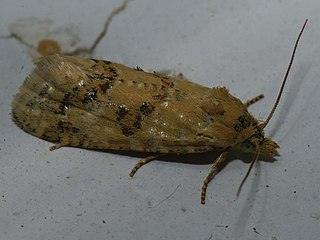
Aethes williana, the silver carrot conch, is a species of moth of the family Tortricidae. It was described by Nikolaus Joseph Brahm in 1791. It is found in most of Europe, Trans-Caspia, Asia Minor, Mongolia, north-western Africa and Iran. It is found in dry, sandy and chalky habitats.
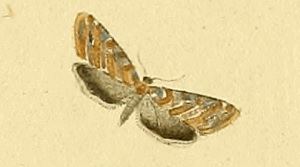
Eupoecilia cebrana is a species of moth of the family Tortricidae. It is found in Sweden, France, Germany, Denmark, Poland, Austria, Slovakia, Estonia, Latvia, Lithuania, Russia, North Macedonia and Greece.
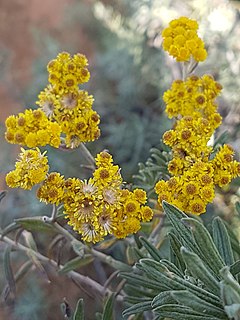
Helichrysum splendidum is a species of flowering plant in the sunflower family Asteraceae, found in Africa and Yemen A hardy evergreen perennial, it occurs from the Southern Cape to Ethiopia along the eastern escarpment mountains, favouring rocky places in fynbos, grassland and savanna biomes. It forms mound-shaped aggregations 1–2 meters high, sometimes covering entire hillsides. The species is found in South Africa, Swaziland, Lesotho, Tanzania, Ethiopia, South Sudan, Malawi, Zimbabwe, Zambia and Yemen. The distribution of this species is clearly anthropogenic, that is, closely linked to the movements of man through the ages.















